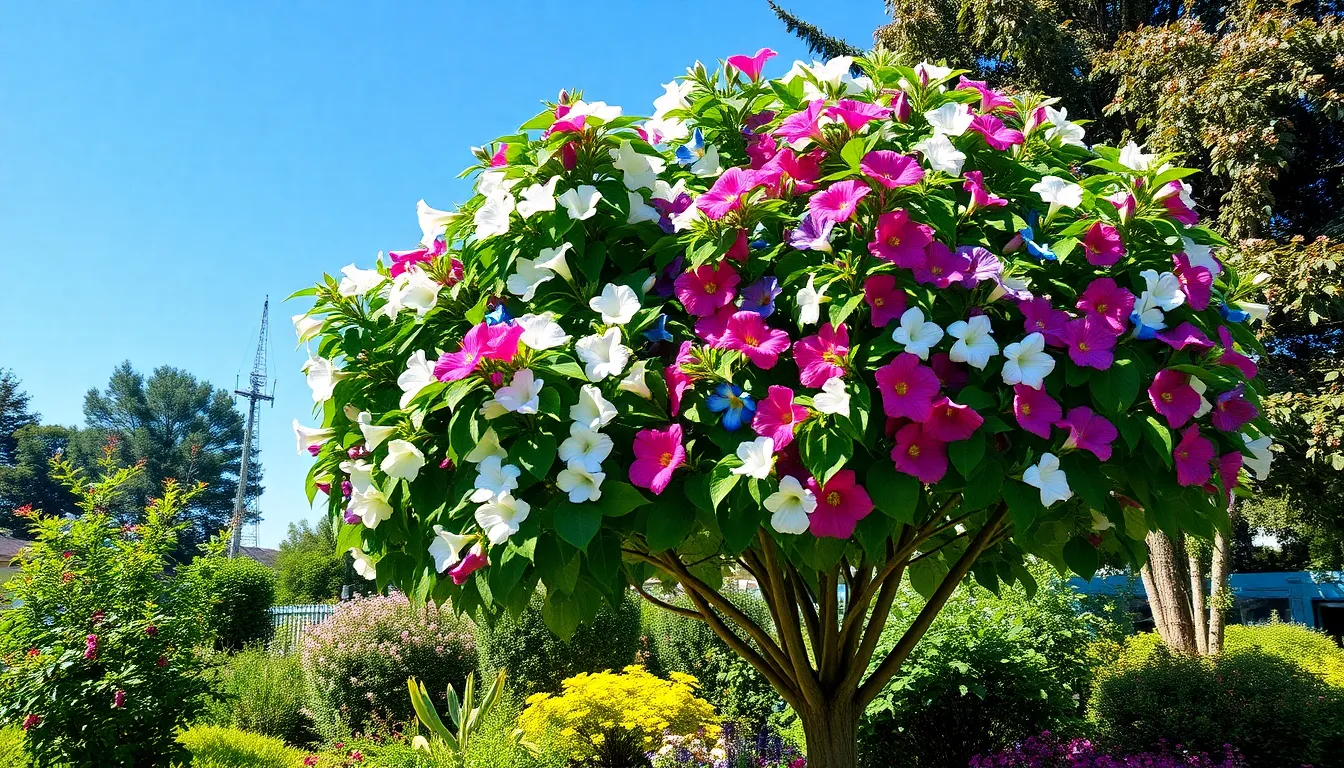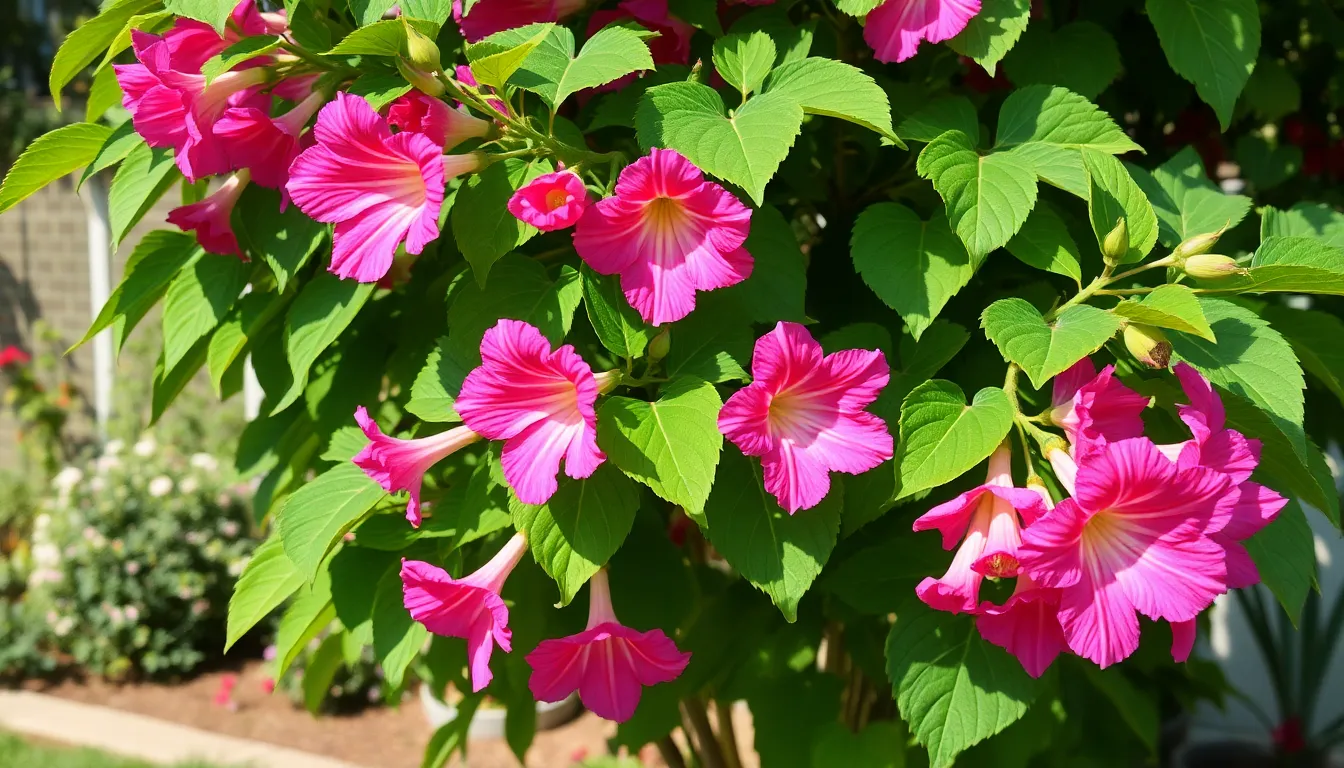Table of Contents
ToggleThe full-grown Rose of Sharon tree isn’t just a pretty face in the garden; it’s a showstopper that brings flair and charm to any landscape. With its vibrant blooms and lush foliage, this tree is like the life of the party, attracting butterflies and curious neighbors alike. Who wouldn’t want a tree that makes their yard the envy of the block?
Overview Of Full Grown Rose Of Sharon Tree
The full grown Rose of Sharon tree, known scientifically as Hibiscus syriacus, typically reaches heights of 8 to 12 feet. This deciduous shrub offers striking flowers that bloom from mid-summer to early fall, showcasing colors like white, pink, blue, and purple. Foliage consists of dark green leaves that create a lush backdrop, enhancing the aesthetic appeal of gardens.
Blooming occurs profusely on new growth, attracting pollinators such as bees and butterflies. These vibrant flowers, often resembling tropical blooms, provide a vivid contrast against the tree’s green foliage. Although the tree thrives in a variety of soil types, it prefers well-drained soil and full sun exposure for optimal growth.
Maintenance involves periodic pruning to shape the tree and encourage healthy growth. It’s resilient to drought once established, making it a low-maintenance choice for homeowners. Planting in groups can create a striking visual effect, while solitary placements allow the tree to serve as a focal point in the landscape.
In terms of habitat, the Rose of Sharon tree adapts well to urban conditions, offering a hearty option for city landscapes. The tree’s ability to withstand heat and humidity adds to its appeal in diverse climates. Through its impressive stature and beautiful blooms, the Rose of Sharon tree effectively enhances outdoor spaces, creating an inviting atmosphere for gatherings and leisure activities.
Characteristics Of Full Grown Rose Of Sharon Tree

The full-grown Rose of Sharon tree exhibits several distinct features. Its size and height, leaf structure, and flower appearance illustrate its unique appeal.
Size And Height
Typically, the Rose of Sharon reaches heights between 8 and 12 feet. Some specimens, under optimal conditions, may grow even taller, achieving 15 feet or more. Widths generally span 4 to 10 feet, allowing for ample space among garden elements. This tree grows upright with a rounded habit, making it an excellent fitting specimen for various landscapes. As it matures, the tree develops a sturdy trunk, further enhancing its presence in outdoor settings.
Leaf Structure
Leaves of the Rose of Sharon are heart-shaped with a glossy finish. Each leaf typically measures 3 to 5 inches in length. Arranged alternately along the stem, they offer a lush backdrop for the stunning flowers. Leaf margins exhibit a serrated or lobed appearance. During autumn, some leaves change color to yellow, adding an extra layer of visual interest to the landscape. This foliage also provides essential shade, enhancing the tree’s recreational space.
Flower Appearance
The flowers bloom from mid-summer to early fall, showcasing vibrant colors such as white, pink, blue, and purple. Each trumpet-shaped flower spans 3 to 4 inches across, complete with a prominent central pistil. Individual blooms last only a day but produce new flowers continuously. This continuous blooming cycle attracts various pollinators, enriching local biodiversity. In addition, the flowers create a stunning visual display that enhances the overall landscape, making it a favorite among gardeners.
Benefits Of Planting Full Grown Rose Of Sharon Tree
The Rose of Sharon tree offers numerous benefits for gardens and landscapes. Its stunning appearance and environmental contributions make it an excellent choice for homeowners.
Aesthetic Appeal
Colorful blooms attract attention during the growing season, showcasing flowers in vibrant shades like white, pink, blue, and purple. Each flower, measuring 3 to 4 inches, creates a breathtaking display from mid-summer to early fall. Heart-shaped, glossy leaves enhance the overall visual effect, providing a lush backdrop. Planting multiple trees together forms a striking visual impact. Solitary placements become beautiful focal points in gardens or yards. Varied heights add depth and dimension to landscapes. This tree not only elevates outdoor spaces but also invites admiration from neighbors and visitors.
Environmental Impact
The full-grown Rose of Sharon tree supports local ecosystems by attracting butterflies and bees, crucial for pollination. Drought resistance reduces water usage, promoting sustainability in landscaping. Shade from the tree provides relief during hot summer months, aiding cooler microclimates. Effective growth in urban conditions improves air quality. Leaf drop in the fall contributes organic material, enriching soil health. The Rose of Sharon tree proves essential for creating bio-diverse habitats while maintaining low maintenance needs. It positively influences surrounding flora and fauna, contributing to a healthier environment.
Maintenance And Care
Maintaining a full-grown Rose of Sharon tree involves regular attention to pruning and pest control for optimal growth.
Pruning Tips
Pruning helps promote healthy growth and shape the tree. Begin by removing dead or crossed branches to improve air circulation. Cutting back stems to their base encourages robust blooms. Focus on pruning during late winter or early spring before new growth begins. You can also shape the tree by trimming it lightly to maintain size and aesthetics. Aim for an open shape to enhance sunlight exposure, which is crucial for flowering. Gardeners often notice that consistent pruning leads to a more vigorous and attractive plant.
Pest Control Strategies
Effective pest control safeguards the health of the Rose of Sharon tree. Regularly inspect leaves for common pests like aphids or spider mites, which can weaken the tree. Introduce natural predators like ladybugs to keep pest populations in check. Applying insecticidal soap or neem oil provides an effective treatment if infestations occur. Maintaining good air circulation and keeping the area around the tree clean minimizes disease and pest issues. Quick action ensures the tree remains vibrant and healthy throughout its growing season.
Common Issues With Full Grown Rose Of Sharon Tree
Full grown Rose of Sharon trees encounter various issues, which can affect their health and appearance. Understanding these issues helps address them effectively.
Disease Susceptibility
Rose of Sharon trees are prone to several diseases. Fungal infections like root rot and leaf spot may occur, especially in overly wet conditions. Bacterial infections such as bacterial wilt can also impact these trees. Recognizing the early symptoms aids in timely treatment. Keeping the area around the tree clean improves air circulation, reducing disease risk. Regular inspections help catch any issues early, ensuring healthy growth.
Weather Resilience
Weather conditions significantly impact the Rose of Sharon’s health. This tree shows a degree of resilience to drought, thriving in low-water environments, but it struggles in extreme cold. Frost damage can occur in late spring if new growth emerges too early. In addition, heavy winds can cause limb breakage, especially if the tree hasn’t been properly pruned. Providing shelter from harsh winds and monitoring temperature fluctuations are vital for maintaining the tree’s vitality.
The full-grown Rose of Sharon tree stands out as a remarkable addition to any garden. With its vibrant blooms and lush foliage it serves not only as a visual delight but also as a valuable contributor to local ecosystems. Its resilience to drought and adaptability to urban environments make it a practical choice for homeowners seeking low-maintenance beauty.
Regular care and attention ensure the tree thrives and continues to attract pollinators while providing shade and enhancing air quality. By choosing the Rose of Sharon tree gardeners can create a stunning focal point in their outdoor spaces while enjoying the numerous benefits it offers. This tree truly embodies the perfect blend of aesthetics and environmental stewardship.





